|
|
Yantras
The Sanskrit word 'yantra' derives from
the root 'yam' meaning to sustain, hold or support the energy inherent in a
particular element, object or concept. In its first meaning, 'yantra' may refer
to any kind of mechanical contrivance which is harnessed to aid an enterprise. A
yantra in this sense, therefore, is any sort of machine or instrument such as is
used in architecture, astronomy,  alchemy, alchemy,
chemistry, warfare or recreation. A  Sanskrit Sanskrit
text of the eleventh century AD, Samaranganasutradhara, on the science of
architecture, gives vivid descriptions of the making and operating of such
mechanical yantras as a wooden flying bird, wooden aeroplanes meant to  fly fly
with hot  mercury mercury
as fuel, male and female robot figures, etc. The vast observatories built in
Delhi and Jaipur under the patronage of Jai Singh (1686-1734) are called
Jantar-Mantar, as their massive structures are astronomical 'instruments' (yantras)
for recording heavenly phenomena.
the meaning of the term yantra has been
expanded to refer to religious enterprises, and has acquired a special
theological significance. Mystic yantras are aids to and the chief instruments
of meditative discipline. Basically a yantra used in this context and for this
purpose is an abstract geometrical design intended as a 'tool' for meditation
and increased awareness."... 
 Archetypal Archetypal
Space & Sacred Sounds:
"In our ordinary  perceptions perceptions
we view space as an amorphous entity which is related to us in units of
measurment. For us space is essentially quantitative; we understand it in terms
of  dimension, dimension,
volume and distance. For the adept who uses yantras in yogic meditation, on the
other hand, space enclosed within the bounded figure is purely qualitative;
space is absolute void and unity is a 'sacrament' by means of which he
communicates with a  force force
that stands for life itself. The yantra is an archetypal unity, and
in the making of every new yantra the archetypal activity and the divine
revelations repeat themselves. Each yantra's consecrated place acts as a
dwelling for the gods, a space where movement from the level of profane
existence to the level of profound realities is made possible. Symbol and
meaning blend so closely that they are one  reality, reality,
indistinguishable from one another."... "Every  yantra creates a power-field, a yantra creates a power-field, a
cosmicized circuit (kshetra) in which the powers of the sacred are invoked. The
lines and planes localized within the yantra, though distinct from all the
spaces that surround its outer circuit, are an expression of a transcendental
reality. Stretching from star to star the ultimate substratum of all forms is
space. Empty space is in itself a primordial substance and shares in the nature
of divinity. Without it, the primordial substance whose abode is the whole
universe would remain without support. Absolute void is defined by Indian
philosophers as a
limitless sea of undifferentiated continuum
which is an ever present entity not detachable from the relative, thus making
all division of space illusory. So the spaces within a yantra, however minute,
can be symbolically brought to 'presence' and expressed as being as immense as
the spaces within the solar system. Although in the abstract this is the
immutable principle on which the space concept of yantras functions, on the
level of human experience we are led to locate the sacred by creating spatial
divisions. The act of bounding the figure, 'fencing' its four quarters, defining
its spatial orientations, delimiting the sacred territory of the yantra, is an
act of asserting where sacred space begins to manifest."... Cosmogenesis: the  Sri Sri
Yantra: "The Sri Yantra, considered the greatest of all yantras,
displays the splendour of Siva-Sakti in their manifestation in order to create
the root principles of life (tattvas). A graphic synthesis of the abstruse
cosmological and  metaphysical metaphysical
theory of Saiva-Sakta, the Sri Yantra is to be read as a chart of the  evolution evolution
of the cosmic scheme, exposing step by step the theory of creation and its
categories. it also demonstrates how the passage from formlessness to form takes
place, as the antagonistic principles of life emanate and differentiate
themselves from the original wholeness of  Siva- Siva- Sakti. Sakti.
The Sri Yantra marks each phase of cosmic evolution and articulates every
descending level of the creative process." process."
yantraguru@hotmail.com
About the temple


Gabbar Hill
|
 |
At a distance of 65 Kms from Palanpur and 45 Kms from Mt. Abu near
Gujarat Rajasthan border the religious town of Ambaji is located. This town
is famous for the Maa Ambaji temple, one of the richest and holiest temple
in Gujarat attracting lakhs of pilgrims from Gujarat and neighbouring
Rajasthan every year. The original seat of Ambaji Mata is on Gabbar Hilltop,
which is 3 Kms away from Ambaji town. Ambaji Mata temple is one of the 51
shakti peeths where it is believed the heart of Goddess Parvati fell.
Ambaji Mata temple at Gabbar is very ancient, origin of which is
lost in antiquity. It is believed that Goddess Amba was one of the deities
of Pre-Aryan race, which Aryans absorbed in their pantheon. On the Gabbar
Hill the footsteps of Goddess are imprinted. The imprint of Her chariot is
also found here. It is believed that the tonsure ceremony of Lord Krishna
also took place here. Ambaji temple has a golden yantra made jointly with
the yantra of Nepal Shaktipeeth at Ujjain. There are 51 shlokas on the
yantra.
Lakhs of devotees visit the temple every year especially on
Purnima days culminating into a large mela on Bhadarvi Purnima. Goddess
Ambaji Mata has been fulfilling wishes of her devotees for thousands of
years. |
|---|
 |
|
|
|---|
 |
For more information and advance block bookings of
tickets, contact:
Resident Manager,
Maa Ambaji
 , ,
Gabbar Hills, Ambaji, Gujarat.
Phone9856478752
Fax: 02749-262726
Email:
yantraguru@hotmail.com
|
How to reach Ambaji |
 |
Distances :
From Ahmedabad – 180 Kms.
From Abu Road station – 20 Kms.
From Mt. Abu – 45 Kms.
From Delhi – 700 Kms.
From Palanpur – 65 Kms.
From Himmat Nagar – 110 Kms. |
 |
Nearest Station : Abu Road
From |
Train No. |
Delhi |
2957, 2916 |
|
 |
Nearest Airport – Ahmedabad
From |
Flight No. |
Delhi |
IC 613 |
Bombay |
9W 323 |
|
Where To Stay In
Ambaji
- Hotel Akash Ganga Phone : 02749-262764
- Balaram Resort Phone : 02742-84278
Local Transportation in
Ambaji
- Taxi , Jeeps, Auto Rickshaw
Other Places to visit in
Ambaji
- Goddess Amba temple in Ambaji town,
Koteshwar temple, Maa Kamakshi temple
Important Festivals in 2003
- Budh Poornima - 16 May.'2003
- Navratri - 26 Sept' 2003 to 4 Oct.'2003
- Diwali - 25 October'2003
Tours and Travels
- Vidhi Travels,
Ahmedabad
Phone : 079-6563065
Other Information at Ambaji
- Police Station
(Ambaji)
Phone : 62148
- Hospital
(Ambaji)
Phone : 62155
|

 |
Important Festivals in 2005
- Makar Sankranti :
14 January' 2006
- Republic Day:
26 January' 2006
- Maha Shivratri:
26 February' 2006
- Somvati Amavas:
27 February 2006
- Chatra Navratra:
30 March ' 2006 to 6 April' 2006
- Mahavir Jayanti :
11 April 2006
- Guru Purnima :
11 June 2006
- Independence Day:
9 August' 2006
- Independence Day:
15 August' 2006
- Rakshabandhan :
8 August 2006
- Krishna Janmashtami:
16 August ' 2006
- Bhadravi Poornima :
7 September 2006
- Sharad Navratra:
23 September to 12 October' 2006
- Diwali :
21 October' 2006
- Gujarati New Year:
22 October' 2006
- Kartik Poornima:
05 November' 2006
Nearby Cities / Places of
Importance
Mount Abu - 45 Kms
The hill resort of Mount Abu on Aravallis is magnificent land of sages and
seers. The major attractions are Nakki Lake, 1000 years old Dilwara Jain
temples, Head Quarters of Brahmkumaris Foundation etc.
Ahmedabad - 180 Kms
Ahmedabad, once associated with Mahatma Gandhi, is renowned as a great
textile and commercial centre. The major attractions are Jama Masjid,
Kankaria Lake, the Shaking Minarets, Rani Rupwati Masjid etc.
Palanpur - 65 Kms
Palanpur is a former princely state ruled by Nawabs. The major attractions
are palaces of the Nawab, Balram Mahadev temple etc. |
|---|
30th March to 7th April 2006
Omkarananda Ashram Himalayas
celebrated Vasant-Navaratri from 30th March to 7th April 2006 with full
fervour. The Pandits of Omkarananda-Kamakshi-Devi Mandir conducted this
festivity in the Yajnashala of the sacred temple.
Every day powerful
prayers and additional Hawanas were conducted. From left to right:
Kumari Somashekhari, Swami Satchidananda, Sanjay Panditji, Suresh Panditji,
Swamini
Vidyaprakashananda and Swami Vishveshwarananda |
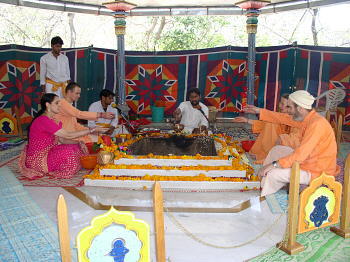
|
The most auspicious rituals
commenced in the morning of 30th March at 7 a.m. with Panchanga Pooja and
Kalasha Sthapana, in which the holy Kalasha was installed along the chanting
of hymns. This grand event was followed by Devi-Maha-Abhishekam followed by
Mandapa-Devata Pooja, Yantra Pooja, Chandi Pooja and Guru Pooja. The last
morning ritual was Chandi Parayana that concluded with Arati, Bhog and
distribution of Prasadam for the devotees and invitees. In the evening Pooja was
conducted for all Deities. Mahaganapati Hawana was performed after Agnimukham.
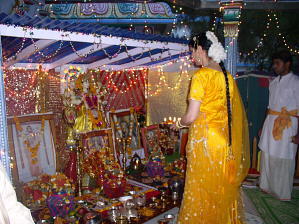
Kumari Somashekhari offers Arati to Gurudev Swami Omkarananda, Durga Maa
and all other Gods and Goddesses |
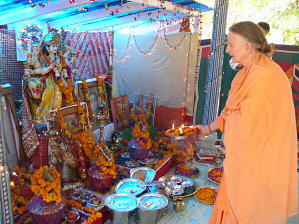
Swamini Vidyaprakashanandaji offers Arati
during the Navaratri-Celebrations
|
From 30th March to 6th April
2006, daily in the morning at 8 a.m., Panchanga Pooja, Devi-Maha-Abhishekam,
Yantra Pooja, Durga Saptashati Parayana were devoutly performed, followed by
Arati, Bhog and distribution of Prasadam. In the evening, after the Poojas
for all the Deities, a special Hawan was performed every day for all Deities,
namely Ganapati, Mahalakshmi, Rudra, Chandi, Durga, Guru and Tripurasundari. On 6th April 2006, Ram Navami, a
special Bhajan and Dance Programme was performed by Kumari Somashekhari and
her students to worship Devi. A separate report of this sparkling event is
given in the following.
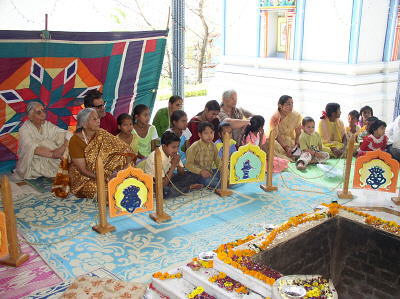
|
Many Ashram-Devotees
took part in our Navaratri-Celebrations with great enthusiasm. |
On 7th April morning, Vijaya
Dashami, the Navaratri Celebrations were concluded with Sarva-Devata Pooja,
Devi Pooja, Agni Mukham, Sarva-Devata Hawana, Navavarana Hawana, Chandi Pooja
and Homa, Maha Purnahuti, Kanya Pooja, Suvasini Puja and Devata Visarjana. The
Hawan on this day lasted for hours and was very impressive. Swami
Vishveshwarananda, Swami Satchidananda, Swamini Vidyaprakashananda, Swami
Narasimhulu and Kumari Somashekhari took part in it, and many guests watched
the Hawan with enthusiasm. Swami Vishveshwarananda, President of Swami
Omkarananda Ashram, performed the auspicious Purnahuti with great devotion.
After completion of the
Purnahuti, nine small girls (Kanyas), were worshipped as Goddesses with Puja,
Arati, Prasadam etc. Beautiful gifts of various items were presented by Kumari
Somashekhari to those children.

Kumari Somashekhari worshiped nine Kanyas and
offered beautiful gifts to them.

After the Puja the Kanyas enjoyed special Prasadam.
|
Swamini Vidyaprakashananda
honoured an elderly married Lady, whose husband is alive, a “Suvasini”, with
Puja and gifts. In the end all received the
Prasadam in the form of Bhandara and thus the Vasant Navaratri concluded.
Everybody taking part in it, deeply felt the unforgettable powerful spiritual
vibrations of this beautiful event in Omkarananda Ashram Himalayas.
 Cultural Cultural
Evening on Ram Navami in
Omkarananda Ashram Himalayas, Muni-ki-reti
As every year, this year too,
Omkarananda Ashram Himalayas has celebrated Navaratri in a grand way.
Omkarananda-Kamakshi-Devi Mandir was nicely decorated with beautiful flowers and
all kinds of lights. The evening of Ram Navami (6th April 2006) was fully
dedicated to the art of Dance and Bhajans to glorify the Deities.
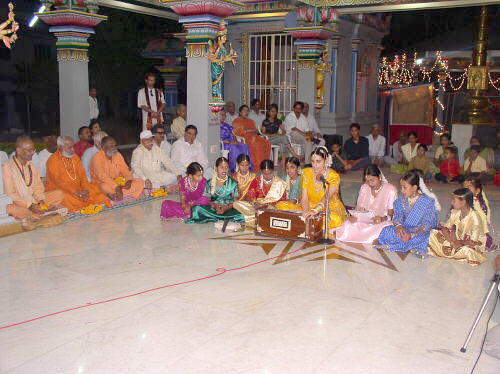
Kumari Somashekhari and her students singing Bhajans
|
Before the function started, a
powerful Yajna took place which was followed by Arati. Later on, in the
Maha-Mandapa of the Temple, the daily Arati, prayers and worship were performed.
After that the students of Kumari Somashekhari, in beautiful costumes, sang
Bhajans under the guidance of Kumari Somashekhari as worship to
Omkarananda-Kamakshi-Devi. This was followed by various dances. Every dance was
explained by Kumari Somashekhari in pure Hindi as well as in English for all
those non-Hindi speaking guests. The temple was packed full with the audience.
There was a sparkling atmosphere, especially when Kumari Somashekhari herself
performed the dances in front of Omkarananda-Kamakshi-Devi.
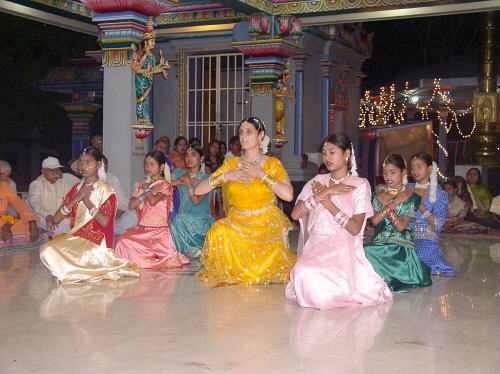
Kumari Somashekhari and her students performing Devi-Dances.
|
All important guests were welcomed
with a flower garland. Among the prominent persons were Swamini
Vidyaprakashananda, monastic disciple of Gurudev Paramahamsa Omkarananda
Saraswati, who actively took part in establishing this beautiful temple, Shri
Varshney, Shri I.D. Joshi, Prof. Rajwar, Shri Singhal, Shri Anil Mehrotra and
Shri Kamal Narayan Mishra. In the end Shri Kamal Narayan Mishra, in a firing
speech, addressed the public.
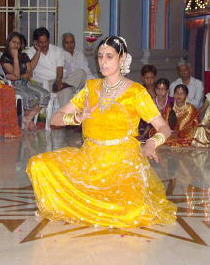
Kumari Somashekhari during
a Solo Dance
|
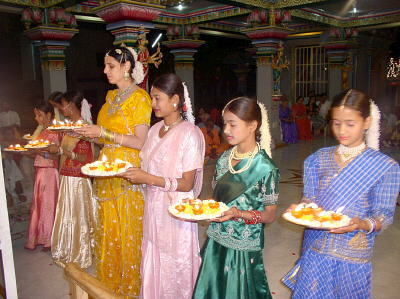
Kumari Somashekhari and her students perform a
Devi-Arati Dance with Deepas and flowers in front of
Divine Mother Shri Omkarananda-Kamakshi-Devi.
|
On this occasion, Kumari
Somashekhari also introduced a group of her students, who henceforth will form
the Omkarananda Bhajan Mandali. The release of a CD will take place soon. A
special issue of the Ashram’s quarterly magazine ‘Vidya Prabodhini’ about the
Omkarananda Mahotsava celebrations, was offered to everybody who attended this
function. The function concluded with Prasad Distribution.
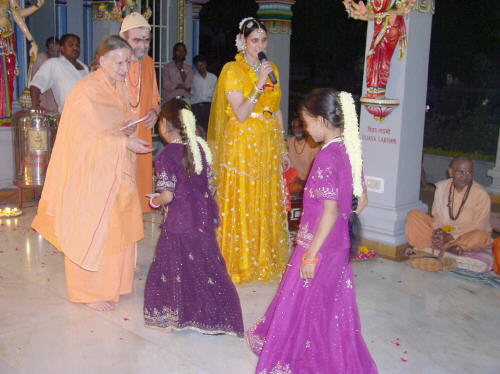
After the dance-performance the students of Kumari
Somashekhari
received gifts from Swamini Vidyaprakashananda.
|
Swami Vishveshwarananda, the
President of the Ashram, himself guided and addressed the function as “Master of
Ceremonies”. Among the Saints, Swami Rakeshananda, Swami Satchidananda,
Narasimhulu Swami and Veeraraghavulu Swami attended the function.
The audience was thrilled by the excellent performance of Kumari Somashekhari
and her students and everybody appreciated that she has taken much pain in
teaching this beautiful art to the children, who are coming from different walks
of life.
 Visit Visit
to Ruskin Bond by Students of
Omkarananda Patanjala Yoga Kendra
on 2nd April 2006
By Saskia, Yoga Student
Oblivious of which bookshop I was
supposed to be to meet Ruskin Bond, I suddenly noticed an elderly man, stoutly
built with a soft and kind expression, comfortably seated on a small chair
amongst hundreds of books, stacked and placed in every possible corner of a tiny
bookshop. This man I had somehow met before, it suddenly occurred to me that it
was Ruskin Bond himself – and the picture became clear. Usha sitting next to him
with sparkling eyes and a glow on her face, her book was being signed by him. I
went in and sat beside him on the small stool at his other side.
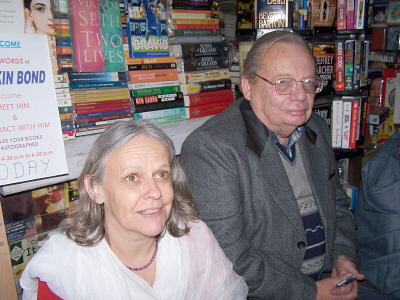 |
Smt. Usha Devi and
Shri Ruskin Bond |
I read but so little of his work,
but the little I had read appealed to me. It was only four days previous to our
meeting that I casually came across Ruskin’s writings in some small bookshop in
Rishikesh. He captivated me at once. This man who writes with such sensuousness
about India, portraying love for life in India, bringing back to life playful
childhood memories, was to touch my heart. To then hear that Usha had
coincidentally arranged to meet Ruskin Bond in Mussoorie Cambridge bookshop was
for me so exciting. I could not help being playful as
if I felt comfortable with him, as if I knew him always. I had remembered
reading in one of his short stories that he as a child often read upside down
and ever since for fun still does. “Do you still read upside down?” I asked him,
he answered as if he enjoyed the question, with a playful smile he replied “Yes
I do, when children ask me I sometimes show them how.” Seated next to him, enjoying his
gentle presence, he signed my books. I just watched him. He could have been my
granddad with his blue mischievous eyes ready for sharing stories. The only
stark difference being that he had adopted Indian gestures along with an Indian
accent. As he asked for my name so to sign my book he looked into my eyes, his
thick glasses seemed to make his eyes go smaller and sweeter. Gradually whole groups of people
came into the shop and without any sort of resistance Ruskin looked each one of
his fans warmly into their eyes, asking for their names so to sign their books.
He commented that this is not very usual to have so many people visiting (I
somehow could not believe him). His English charm and politeness seemed to still
be a part of his heritage. The afternoon flew by. Meanwhile
all of us Yoga students from Omkarananda Patanjala Yoga Kendra were gathered
around him. Coincidentally a Yoga group from Delhi dropped into the bookshop to
greet Ruskin as well. Ruskin was surrounded by young
Yoga ladies, and I think he seemed to secretly enjoy all the attention. We were
offered coffee by the bookshop keeper and shared stories of monkeys sitting on
potties and traffic jams in Delhi. By the end of the afternoon he concluded that
it may be time to write something about Yoga as there are so many Yoga students
around nowadays. I cannot but think of him as a charming gentleman who may
someday flatter us all with a book about Yoga.
|
|
|
![]() alchemy,
alchemy,![]() Sanskrit
Sanskrit![]() fly
fly![]() mercury
mercury
![]() Archetypal
Archetypal![]() perceptions
perceptions![]() dimension,
dimension,![]() force
force![]() reality,
reality, yantra creates a power-field, a
yantra creates a power-field, a![]() Sri
Sri![]() metaphysical
metaphysical![]() evolution
evolution![]() Siva-
Siva-![]() Sakti.
Sakti.![]() process."
process."


















